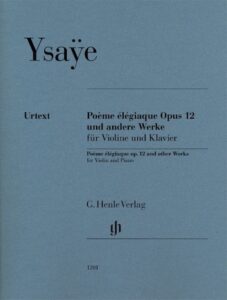Early works by Eugène Ysaÿe
Eight pieces, composed long before the famous six solo sonatas, presented with the respective histories of their composition.

The Belgian violinist Eugène Ysaÿe (1858-1931), first a pupil of his father, won a prize at the age of nine, studied with Wieniawski in Brussels and Vieuxtemps in Paris and played Beethoven's C minor Sonata with Clara Schumann on his first concert tour in Germany in 1878. In 1882, Anton Rubinstein took him on a tour to Russia and Norway. At his wedding feast with the singer Louise Bourdeau, he played the sonata by César Franck dedicated to him, then moved to Brussels as a professor, where he taught until 1898 (famous pupils: Gingold, Primrose, Persinger). During the First World War, he lived in London, later in the USA, before finally returning to Brussels, where he worked as a conductor, teacher and concert manager until his death.
Throughout his life, he used composing as a source of energy and a refuge. His most important legacy are the six solo sonatas op. 27, composed in 1923. This booklet sheds light on the works from 1882 to 1905, written at his various places of activity. It demonstrates his stupendous, spiritualized virtuosity. Of the eight printed works, the Légende norvégienne a worthwhile first publication. The foreword by Marie Cornaz (d/f/e) tells the exciting story of the pieces. In the detailed notes (d/e), the Japanese violinist Ray Iwazumi, who teaches at the Juilliard School and specializes in Ysaÿe's musicology, offers his help. Unusual: in the violin part, Ysaÿe's original fingerings and line markings are printed in black, Iwazumi's in gray.

Eugène Ysaÿe: Poème élégiaque op. 12 and other works for violin and piano, edited by Ray Iwazumi, HN 1201, € 42.00, G. Henle, Munich







